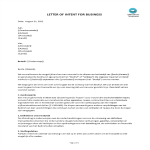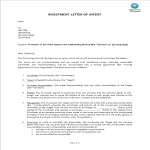Intentieverklaring to Purchase

Opslaan, invullen, afdrukken, klaar!
De beste manier om een Intentieverklaring to Purchase te maken? Check direct dit professionele Intentieverklaring to Purchase template!
Beschikbare bestandsformaten:
.docx- Gevalideerd door een professional
- 100% aanpasbaar
- Taal: English
- Digitale download (26.74 kB)
- Na betaling ontvangt u direct de download link
- We raden aan dit bestand op uw computer te downloaden.
Zakelijk aankoop brief termen brieven voornemen Opdracht Letter Of Intent Intentieverklaring voor baan
How to create a letter of intent to purchase? What does a letter of intent to purchase mean? Our Letter of Intent template can be downloaded and used. It provides a clear and legally binding document that outlines the terms and conditions for the purchase of a property. It also covers all essential details such as the purchase price, closing date, and any contingencies.
A Letter of Intent to Purchase (LOI) is a document that outlines the preliminary agreement between two parties regarding the potential purchase of a property, business, or other assets. It serves as a formal declaration of the buyer's intention to proceed with the transaction under certain terms and conditions.
Key elements typically included in a Letter of Intent to Purchase may include:
- Identification of Parties: Clearly state the names and addresses of both the buyer and the seller.
- Description of the Transaction: Specify the nature of the proposed purchase, including details about the property, business, or assets involved.
- Purchase Price: Outline the proposed purchase price or a method for determining the price. This section may also address the payment structure, such as any deposits or financing arrangements.
- Due Diligence: Specify a period during which the buyer will conduct due diligence to investigate the property, business, or assets. This may include reviewing financial records, contracts, and other relevant documents.
- Conditions Precedent: Outline any conditions that must be met before the transaction can proceed. These conditions could include obtaining financing, securing necessary approvals, or resolving outstanding issues.
- Confidentiality: Include a confidentiality clause to protect sensitive information exchanged during the negotiation process.
- Exclusivity or Non-Binding Nature: Clarify whether the letter of intent is binding or non-binding. In many cases, LOIs are considered non-binding, indicating that they are a statement of intent but not a legally enforceable contract.
- Timeline: Specify key dates and deadlines, such as the expiration date of the letter of intent or the anticipated closing date.
- Termination: Include provisions outlining the circumstances under which either party can terminate the letter of intent.
It's important to note that while a Letter of Intent to Purchase is a significant step in the negotiation process, it is usually not a legally binding contract. Instead, it serves as a roadmap for the parties to move forward with the more detailed and legally binding documents, such as a purchase agreement, that will be drafted during the later stages of the transaction.
Download this template now for your own benefit!
DISCLAIMER
Hoewel all content met de grootste zorg is gecreërd, kan niets op deze pagina direct worden aangenomen als juridisch advies, noch is er een advocaat-client relatie van toepassing.
Laat een antwoord achter. Als u nog vragen of opmerkingen hebt, kunt u deze hieronder plaatsen.



